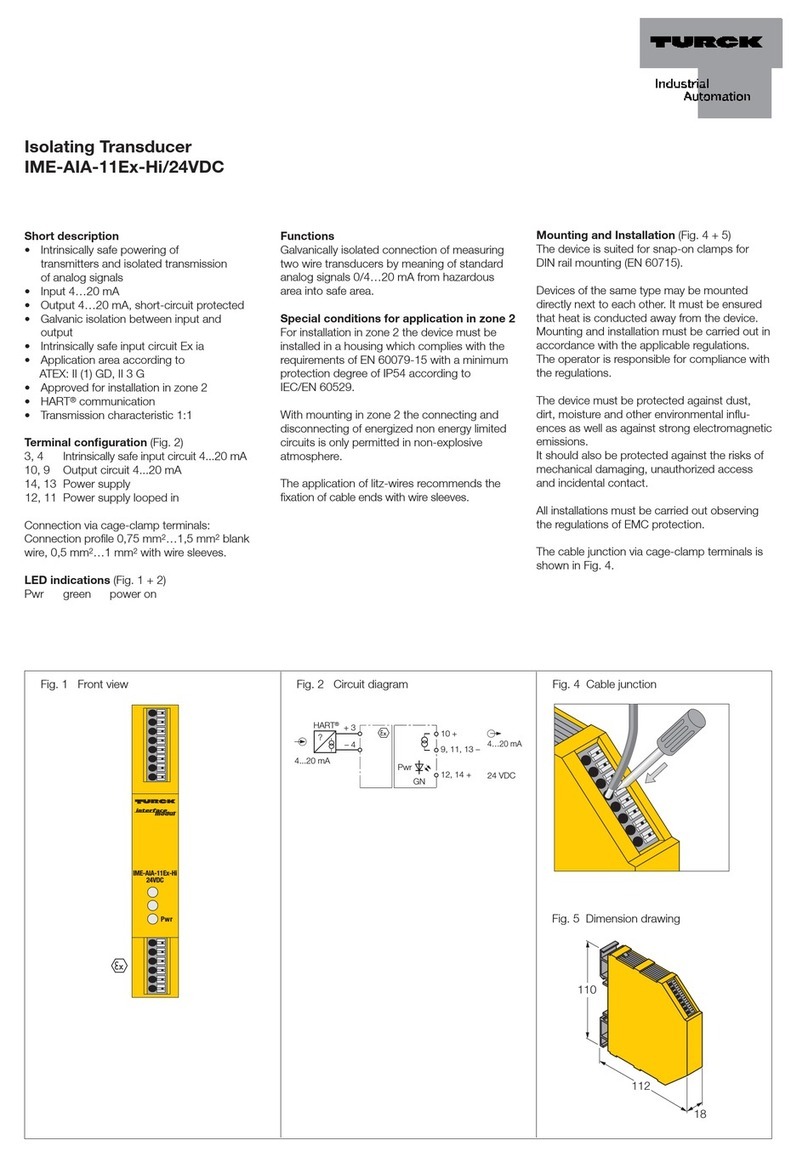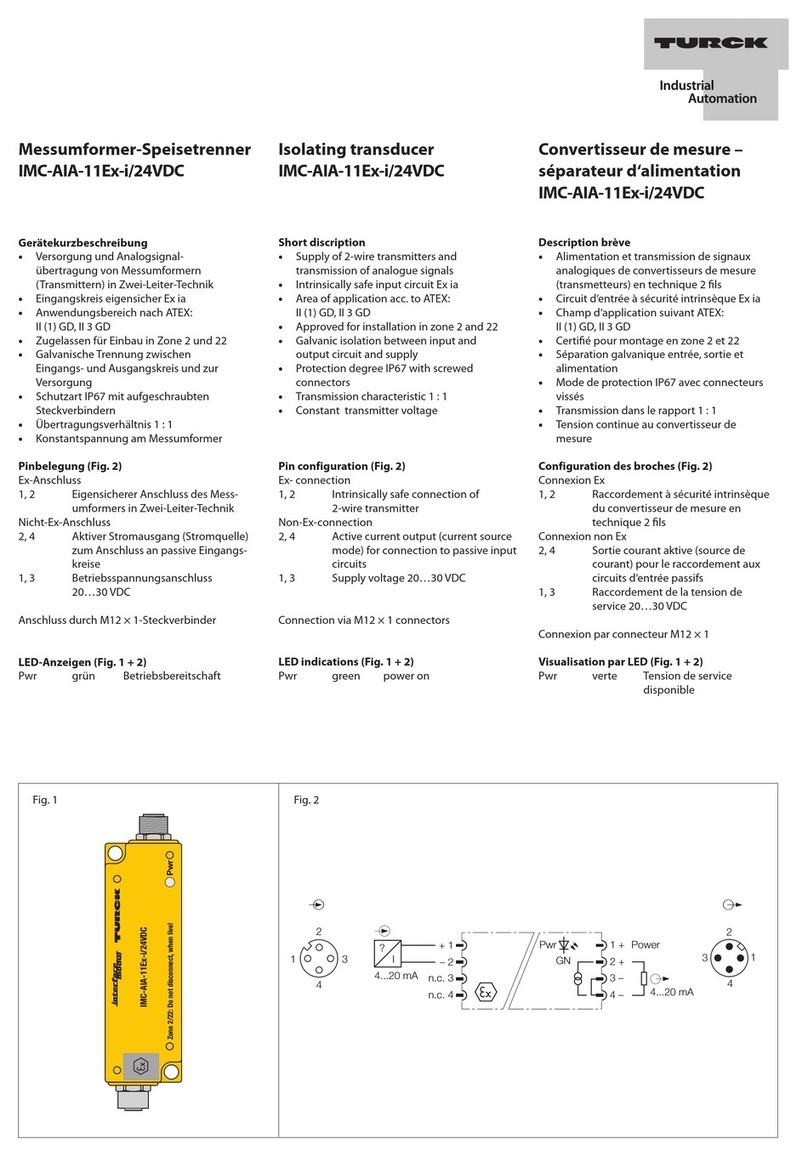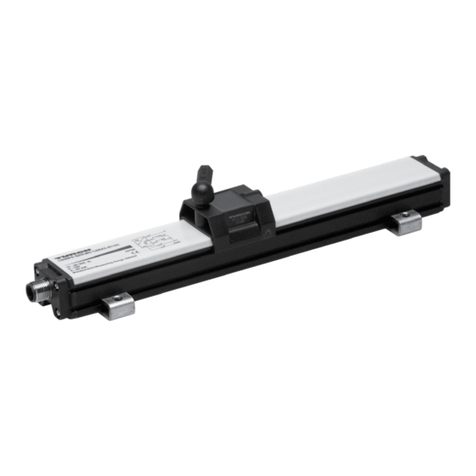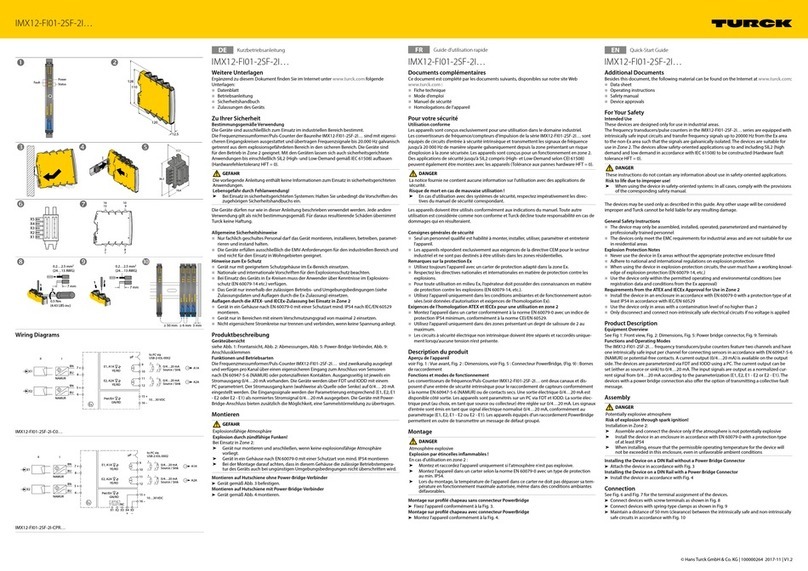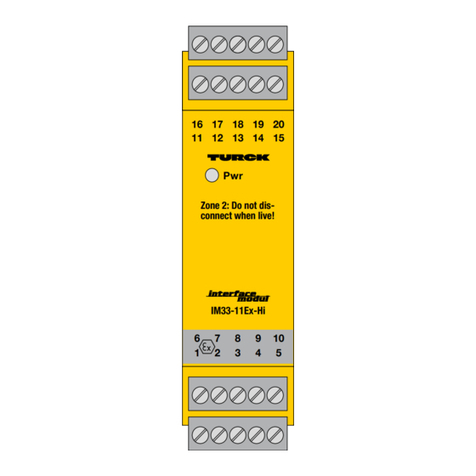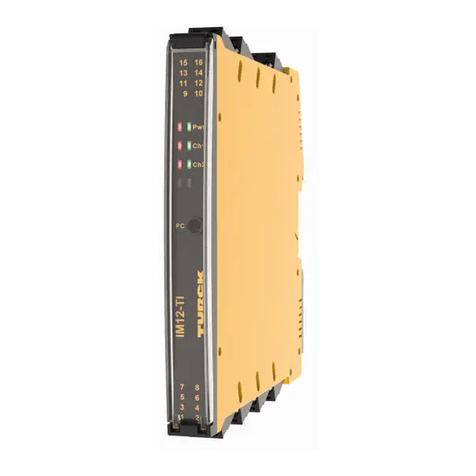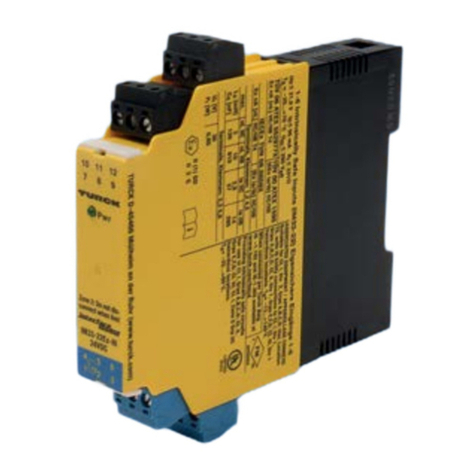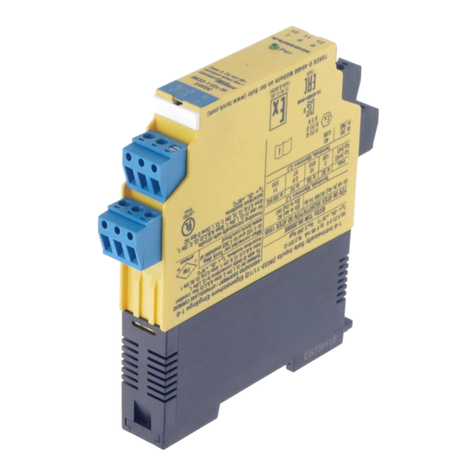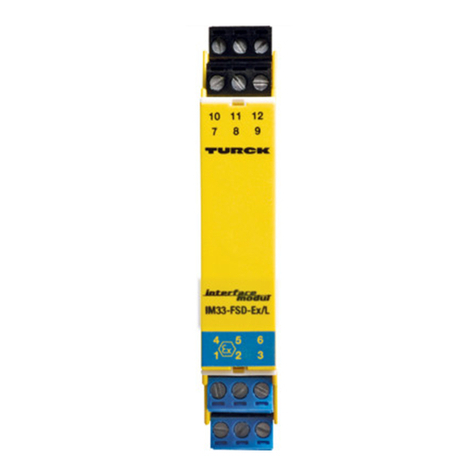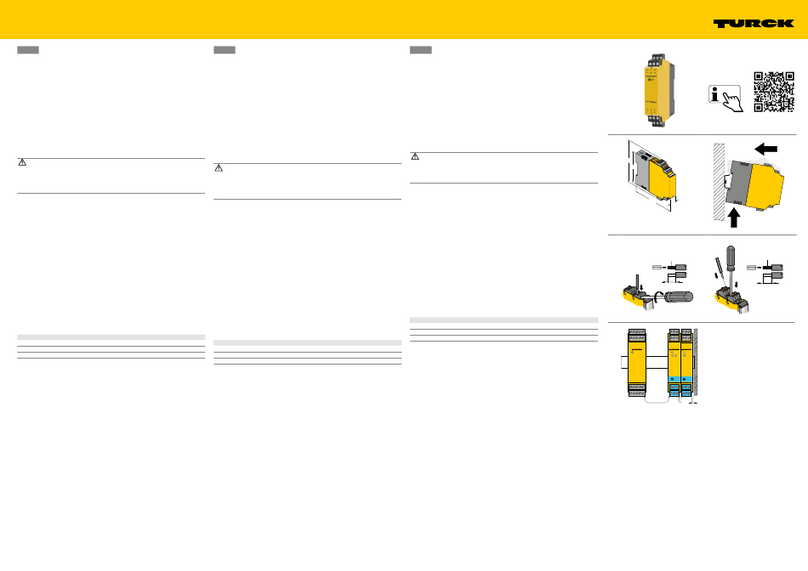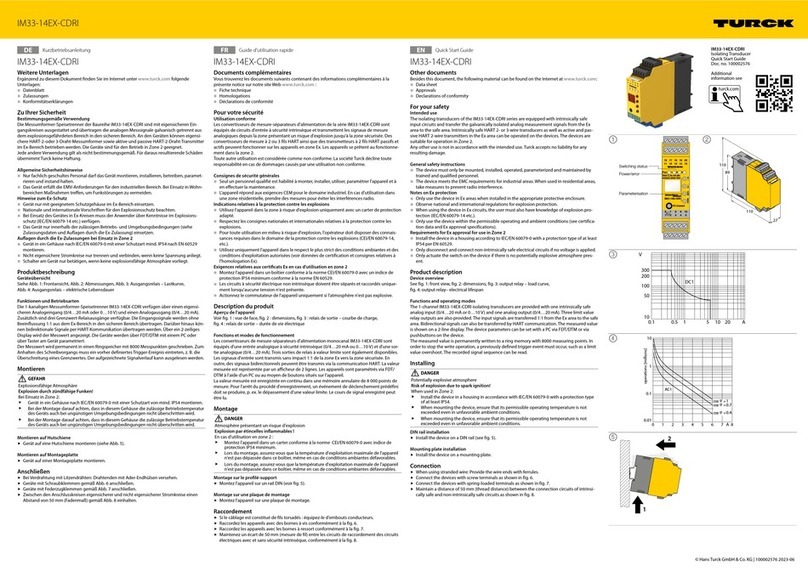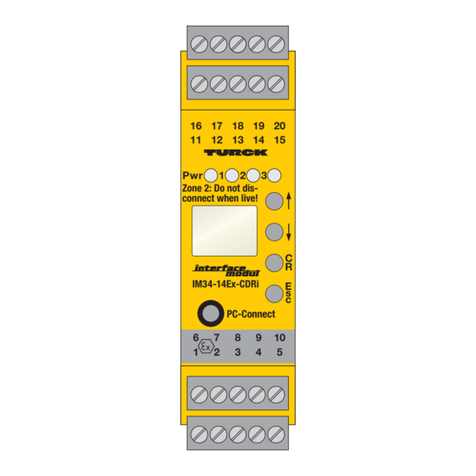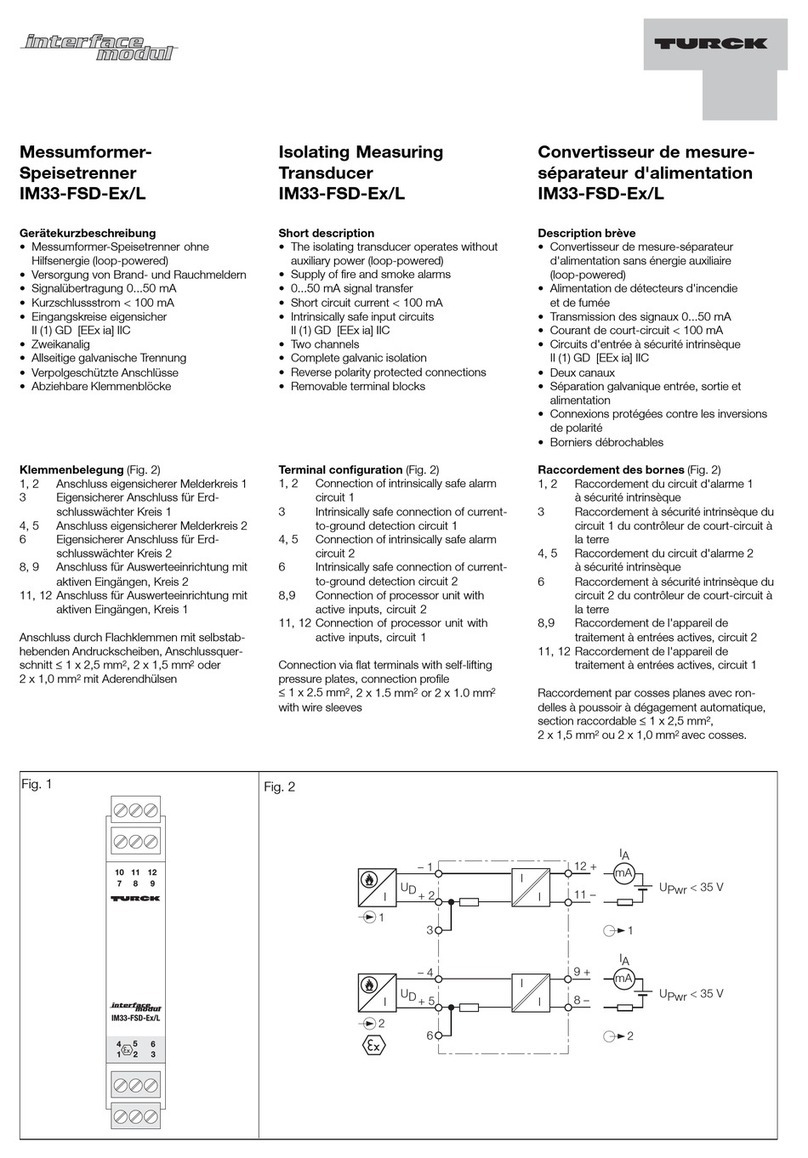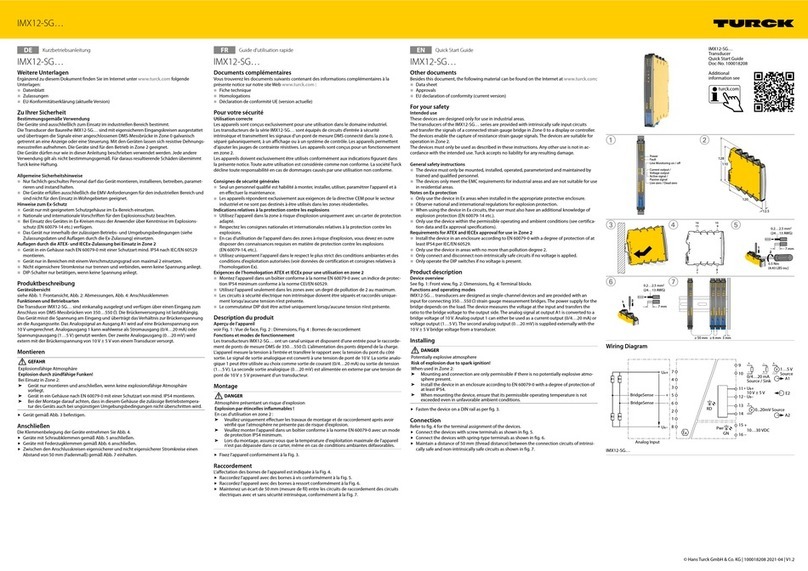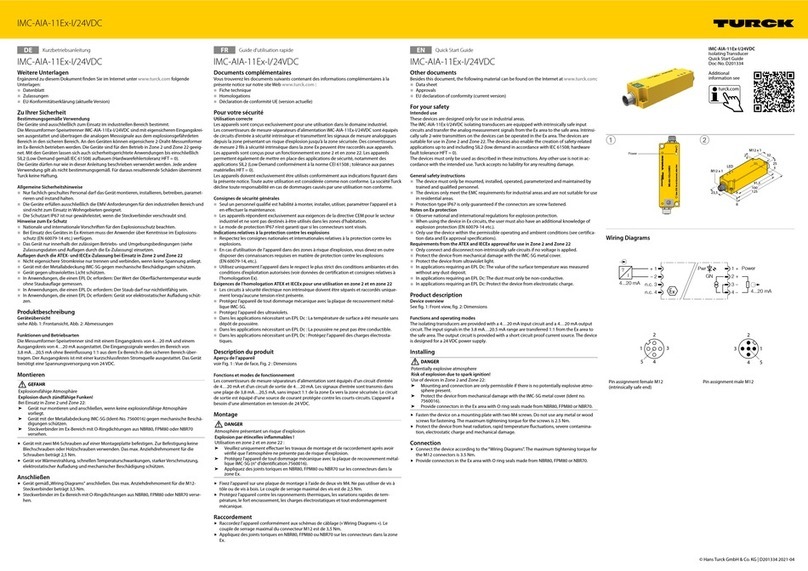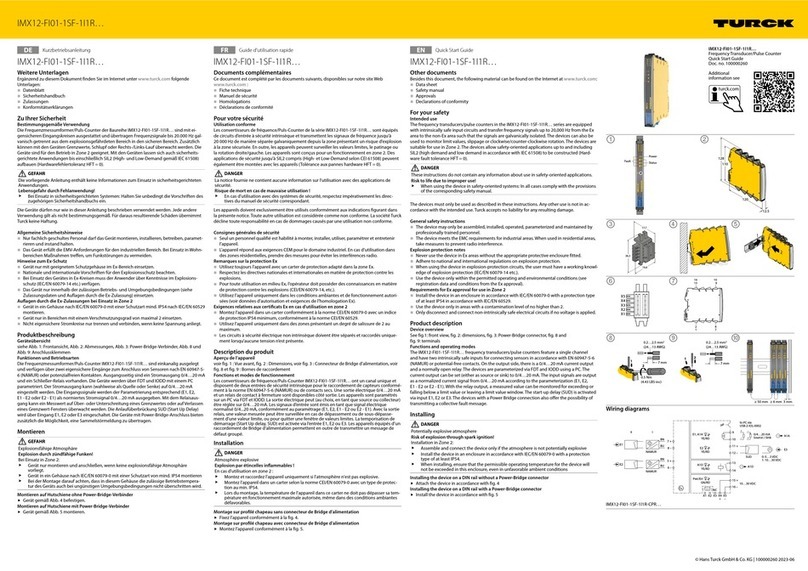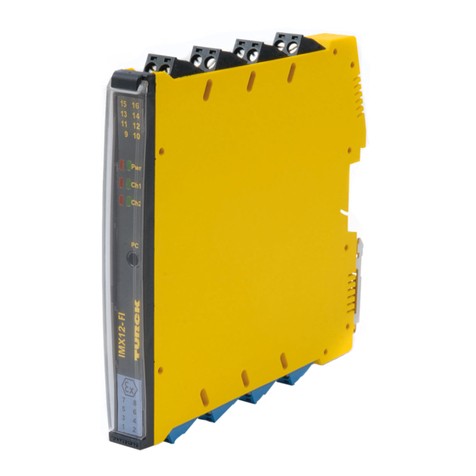
IM33-…Ex-Hi/24VDC
ì ì ì
Wichtige Hinweise zum Einsatz von Geräten mit
eigensicheren Stromkreisen
Das vorliegende Gerät verfügt an den blau gekennzeichneten
Klemmen 1 – 6 über Stromkreise der Zündschutzart
„Eigensicherheit“ für den Explosionsschutz gemäß EN 60079-11.
Die eigensicheren Stromkreise sind von autorisierten Prüfungs-
stellen bescheinigt und für die Verwendung in den jeweiligen
Ländern zugelassen.
Beachten Sie für den bestimmungsgemäßen Betrieb in
explosionsgefährdeten Bereichen unbedingt die nationalen
Vorschriften und Bestimmungen und halten Sie diese ein.
Nachfolgend erhalten Sie einige Hinweise, insbesondere
hinsichtlich der Rahmen-Richtlinie der Europäischen Union
94/9/EG (ATEX).
Das vorliegende Gerät ist ein zugehöriges Betriebsmittel, das
neben eigensicheren auch über nichteigensichere Stromkreise
verfügt. Es darf nur außerhalb des Ex-Bereiches in trockenen,
sauberen und gut überwachten Räumen installiert werden.
Bei Errichtung innerhalb des explosionsgefährdeten Bereichs
der Kategorie 1 und 2 müssen die Geräte in entsprechende
Gehäuse eingebaut werden. Dieser Einbau muss gesondert
geprüft und bescheinigt werden.
Liegt eine Konformitätsaussage oder Erklärung des Herstellers
als Gerät der Kategorie 3 vor, darf eine Installation in Zone 2
erfolgen. Die besonderen Bedingungen zum sicheren Betrieb
sind zu beachten.
An die eigensicheren Anschlüsse können eigensichere elek-
trische Betriebsmittel angeschlossen werden. Alle Betriebsmit-
tel müssen die Voraussetzungen zum Betrieb in der vorhan-
denen Zone des explosionsgefährdeten Bereiches erfüllen.
Führen die eigensicheren Stromkreise in staubexplosionsge-
fährdete Bereiche der Zone 20 bzw. 21, ist sicherzustellen, dass
die Geräte, die an diese Stromkreise angeschlossen werden, die
Anforderungen für Kategorie 1D bzw. 2D erfüllen und entspre-
chend bescheinigt sind.
Werden die Betriebsmitteln zusammengeschaltet, muss der
„Nachweis der Eigensicherheit“ durchgeführt werden
(EN 60079-14). Bereits durch den einmaligen Anschluss von
eigensicheren Stromkreisen an nicht eigensichere Kreise ist
eine spätere Verwendung als Betriebsmittel mit eigensicheren
Stromkreisen nicht mehr zulässig.
Für die Errichtung eigensicherer Stromkreise, die Montage an
äußeren Anschlussteilen sowie für die Beschaenheit und Verle-
gung von Leitungen gelten einschlägige Vorschriften.
Leitungen und Klemmen mit eigensicheren Stromkreisen müs-
sen gekennzeichnet werden – bei farbiger Kennzeichnung ist
hellblau zu verwenden. Sie sind von nichteigensicheren Strom-
kreisen zu trennen oder müssen eine entsprechende Isolierung
aufweisen (EN 60079-14). Zwischen den Anschlussteilen eigen-
sicherer und nichteigensicherer Stromkreise muss ein Abstand
(Fadenmaß) von 50 mm eingehalten werden. Anschlussteile
eigensicherer Stromkreise müssen 6 mm voneinander getrennt
sein. Beachten Sie das max. Anzugsdrehmoment von 0,5 Nm
zum Andrehen der Klemmenschrauben.
Halten Sie von den eigensicheren Anschlüssen dieses Gerätes
den vorgeschriebenen Abstand zu geerdeten Bauteilen und
Anschlüssen anderer Geräte ein. Soweit nicht ausdrücklich
in der gerätespezischen Anleitung angegeben, erlischt die
Zulassung durch Önen des Gerätes, Reparaturen oder Eingrie
am Gerät, die nicht vom Sachverständigen oder Hersteller
ausgeführt werden.
Sichtbare Veränderungen am Gerätegehäuse, wie z. B. bräun-
lich-schwarze Verfärbungen durch Wärme sowie Löcher oder
Ausbeulungen weisen auf einen schwer wiegenden Fehler hin.
Daraufhin das Gerät unverzüglich abschalten. Bei zugehörigen
Betriebsmitteln müssen die angeschlossenen eigensicheren
Betriebsmittel ebenfalls überprüft werden.
Die Überprüfung eines Gerätes hinsichtlich des Explosions-
schutzes kann nur von einem Sachverständigen oder vom
Hersteller vorgenommen werden.
Der Betrieb der Geräte ist nur im Rahmen der auf dem Gehäuse
aufgedruckten bzw. in der Dokumentation aufgeführten zuläs-
sigen Daten gestattet. Insbesondere sind eventuell aufgeführte
Besondere Bedingungen in der EG-Baumusterprüfbeschei-
nigung bzw. Conditions of Certication des IECEx CoC zu
beachten.
Vor jeder Inbetriebnahme oder nach Änderung der Gerätezu-
sammenschaltung ist sicherzustellen, dass die zutreenden
Bestimmungen, Vorschriften und Rahmenbedingungen einge-
halten werden, ein bestimmungsgemäßer Betrieb gegeben ist
und die Sicherheitsbestimmungen erfüllt sind.
Die Montage und der Anschluss des Gerätes muss von geschul-
tem und qualiziertem Personal mit Kenntnis der einschlägigen
nationalen und anzuwendenden internationalen Vorschriften
über den Ex-Schutz durchgeführt werden.
Die wichtigsten Daten aus der EG-Baumuster prüfbeschei-
nigung sind umseitig aufgeführt. Alle gültigen nationalen und
internationalen Bescheinigungen der TURCK-Geräte nden Sie
im Internet (www.turck.com).
Die Besonderen Bedingungen IECEx CoC sind unter
www.iecex.com zu nden.
Weitere Informationen zum Ex-Schutz stellen wir Ihnen auf
Anfrage gern zur Verfügung.
Important information on use of devices with intrin-
sically safe circuits
This device is equipped with circuits featuring protection type
„intrinsic safety“ for explosion protection per EN 60079-11 at
terminals 1 – 6 which are marked in blue. The intrinsically safe
circuits are approved by the authorised bodies for use in those
countries to which the approval applies.
For correct usage in explosion hazardous areas please observe
and follow the national regulations and directives strictly.
Following please nd some guidelines referring to the frame-
work directive of the European Union 94/9/EC (ATEX).
This device is classied as an associated apparatus which is
equipped with intrinsically safe and non-intrinsically safe
circuits. Therefore it may only be installed in the non-explosion
hazardous area in dry clean and well monitored locations.
Installation in explosion hazardous areas of the categories 1
and 2 requires mounting of the devices in appropriate hous-
ings, followed by special tests and authorization.
If a declaration of conformity or declaration of the manufac-
turer as a category 3 device exists, the device may be installed
in zone 2. Special instructions for safe operation must be
observed.
It is permitted to connect intrinsically safe equipment to the
intrinsically safe connections of this device.
All electrical equipment must comply with the regulations ap-
plying to use in the respective zone of the explosion hazardous
area.
If the intrinsically safe circuits lead into explosion hazardous
areas subject to dust hazards, i.e. zone 20 or 21, it must be
ensured that the devices which are to be connected to these
circuits, meet the requirements of category 1D or 2D and
feature an according approval.
When interconnecting devices within such an assembly it is
required to keep and provide a proof of intrinsic safety
(EN 60079-14).
Once that intrinsically safe circuits have been connected to the
non-intrinsically safe circuit, it is not permitted to use the device
subsequently as intrinsically safe equipment.
The governing regulations cover installation of intrinsically safe
circuits, mounting to external connections, cable characteristics
and cable installation.
Cables and terminals with intrinsically safe circuits must be
marked. In case of color coding, light-blue must be used. They
should be separated from non-intrinsically safe circuits or must
feature appropriate insulation (EN 60079-14). A thread measure
of 50 mm must be observed between intrinsically safe and
non-safe connections. Between intrinsically safe connections a
thread measure of 6 mm is required. Please observe the max.
torque of 0.5 Nm to tighten the terminal screws
The approval expires if the device is repaired, modied or
opened by a person other than the manufacturer or an expert,
unless the device-specic instruction manual explicitly permits
such interventions.
Visible damages of the device’s housing (e. g. black-brown
discolouration due to heat accumulation, perforation or
deformation) indicate a serious error and the device must be
turned o immediately. When using associated apparatus it is
required to check the connected intrinsically safe equipment
too. This inspection may only be carried out by an expert or the
manufacturer.
Operation of the devices is only permissible in accordance with
the allowed specications which are printed on the housing
and/or listed in the documentation. Special conditions men-
tioned in the EC type test examination certicate i.e.
Conditions of Certication of the IECEx CoC have to be
followed.
Prior to initial set-up or after every alteration of the interconnec-
tion assembly it must be assured that the relevant regulations,
directives and framework conditions are observed, that opera-
tion is error-free and that all safety regulations are fullled.
Mounting and connection of the device may only be carried out
by qualied and trained sta familiar with the relevant national
and international regulations of explosion protection.
The most important data from the EC type examination
certicate are listed overleaf. All valid national and interna-
tional approvals covering Turck devices are obtainable via the
Internet (www.turck.com). The special conditions of IECEx CoC
can be accessed on www.iecex.com.
Further information on explosion protection is available on
request.
Informations importantes sur l‘utilisation d‘appareils
avec des circuits de courant à sécurité intrinsèque
Cet appareil est équipé aux bornes bleues 1 – 6 de circuits de
courant en mode de protection„sécurité intrinsèque“ pour la
protection contre les explosions suivant EN 60079-11.
Les circuits de courant à sécurité intrinsèque disposent d‘un
certicat accordé par les laboratoires agréés et sont permis
pour l‘utilisation dans les pays concernés.
Son fonctionnement conformément aux dispositions dans
les atmosphères explosives implique le respect des prescrip-
tions et dispositions nationales.
Ci-dessous sont énumérés quelques conseils, particulièrement
concernant la directive-cadre de l‘Union européenne 94/9/EC
(ATEX).
Cet appareil est du matériel électrique équipé non seulement
de circuits de courant à sécurité intrinsèque, mais aussi de
circuits de courant non à sécurité intrinsèque. Il ne peut être
installé en dehors de la plage Ex dans des lieux secs, propres et
bien surveillés. En cas de réalisation dans la zone explosible des
catégories 1 et 2, les appareils sont à monter dans des boîtiers
adéquats. Cette installation doit être contrôlée et certiée.
Si une déclaration de conformité ou explication du fabricant
comme appareil de la catégorie 3 est disponible, une installa-
tion en zone 2 peut être eectuée. Les instructions particulières
d‘un fonctionnement sûr sont à respecter.
Du matériel électrique à sécurité intrinsèque peut être
raccordé aux connexions à sécurité intrinsèque à condition
que ce matériel électrique à sécurité intrinsèque remplisse les
exigences pour le fonctionnement dans la zone actuelle de la
zone explosible.
Lorsque les circuits de courant à sécurité intrinsèque se
trouvent dans les zones présentant des risques d'explosion de
poussière de la zone 20 ou 21, il doit être assuré que les appa-
reils qui seront raccordés à ces circuits de courant, remplissent
les exigences de la catégorie 1D ou 2D et qu'ils disposent d'un
certicat.
En cas d‘interconnexion de matériels électriques la„preuve
de la sécurité intrinsèque“ doit être remplie (EN 60079-14).
Même le raccordement unique de circuits de courant à sécurité
intrinsèque à des circuits non à sécurité intrinsèque ne permet
plus un fonctionnement ultérieur comme matériel électrique à
sécurité intrinsèque.
Pour la réalisation de circuits de courant à sécurité intrinsèque,
le montage à des pièces de raccordement extérieures, ainsi que
pour la qualité et le cheminement des conducteurs les prescrip-
tions concernées sont à respecter.
Les câbles et les bornes à circuits de courant à sécurité
intrinsèque doivent être marqués – en cas de marquage coloré
utiliser bleu clair. Ils doivent être déconnectés de circuits de
courant non à sécurité intrinsèque ou ceux doivent être équipés
d'une isolation appropriée (EN 60079-14). Une distance de 50
mm (écart) entre les pièces de raccordement à sécurité intrin-
sèque et les circuits de courant non à sécurité intrinsèque est à
respecter. Les pièces de raccordement de circuits de courant à
sécurité intrinsèque doivent être séparés 6 mm l'une de l'autre.
Veuillez respecter le couple de serrage max. de 0,5 Nm pour
serrer les vis d’arrêt.
Quant aux raccordements à sécurité intrinsèque de cet appareil,
la distance prescrite entre les composants mis à la terre et les
raccordements d‘autres appareils est à respecter. Sauf s‘il est
indiqué dans le mode d‘emploi spécique de l‘appareil, l‘homo-
logation n‘est plus valable en cas d‘ouverture de l‘appareil,
ou si des réparations ou des interventions sont eectuées à
l‘appareil par des personnes autres que des spécialistes ou que
le fabricant.
Des transformations visibles au boîtier de l‘appareil telles que
par ex les décolorations brunâtres noires par la chaleur ainsi
que des trous ou des gonements, indiquent un défaut grave
impliquant la désactivation immédiate de l‘appareil. Quant au
matériel électrique associé, le matériel électrique à sécurité
intrinsèque raccordé doit également être contrôlé.
Le contrôle d‘un appareil en ce qui concerne la protection
contre les explosions ne peut être eectué que par un
spécialiste ou le fabricant. Le fonctionnement des appareils
est uniquement permis dans le cadre des données admissibles
imprimées sur le boîtier ou mentionnées dans la documenta-
tion. Des conditions particulières eventuellement énumérées
dans l‘attestation d‘examen de type CE ou les Conditions of
Certication de l‘IECEx CoC sont à respecter. Avant toute
mise en service ou après modication de l‘interconnexion des
appareils, on doit veiller à ce que les dispositions, les prescrip-
tions et les conditions-cadre concernées sont respectées, que le
fonctionnement est conforme aux dispostions et que les dispo-
sitions de sécurité sont remplies. Le montage et le raccorde-
ment de l‘appareil ne peut être eectué que par des personnes
qualiées qui sont au courant des prescriptions nationales et
internationales sur la protection Ex concernées.
Les données essentielles de l‘attestation d‘examen CE
gurent au verso. L‘ensemble des certicats nationaux et
internationaux des appareils TURCK peuvent être obtenus par
internet (www.turck.com). Les Conditions particulières
IECEx CoC peuvent être consultées sur www.iecex.com.
Plus d’informations sur la protection Ex peuvent être obtenues
sur demande.

